
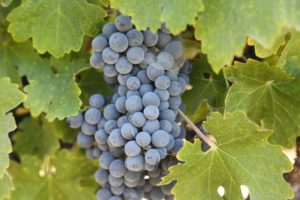 Trotter 1/16th Wines was founded with a 2011 vintage by long time Napa winemaker Stephanie Trotter-Zacharia. Stephanie has been working in the Napa Valley since 1996. But her story of how she arrived in Napa starts much earlier than that. At age 18 she left her home in Philadelphia and headed west – ultimately trying to reach Alaska. However, as she reached the west coast, she ran out of money in Penngrove in neighboring Sonoma County and settled there for 10 years. She likes to joke that it is fortunate she ran out of money in this part of the country, rather than in Alaska (referencing the brutal winters and where she presumably would not have built a career as a winemaker).
Trotter 1/16th Wines was founded with a 2011 vintage by long time Napa winemaker Stephanie Trotter-Zacharia. Stephanie has been working in the Napa Valley since 1996. But her story of how she arrived in Napa starts much earlier than that. At age 18 she left her home in Philadelphia and headed west – ultimately trying to reach Alaska. However, as she reached the west coast, she ran out of money in Penngrove in neighboring Sonoma County and settled there for 10 years. She likes to joke that it is fortunate she ran out of money in this part of the country, rather than in Alaska (referencing the brutal winters and where she presumably would not have built a career as a winemaker).
There is a reason Stephanie left to find her own way, promptly at the age of 18. She is one of 16 children; for those interested, she is #15 of the 16 kids. Whoa! Creatively, her label Trotter 1/16 pays heritage and honor to her own small fraction of her family – an honor that perhaps comes from the perspective of age as well as her own geographical distance from a family of this size. She had to create her own path as winemaking was not something she grew up with.
Her father Thomas James Trotter was a pretzel baker who founded Hatfield Pretzel Baking Company in 1953, (Trotter Soft Pretzel Company) in Hatfield, PA and her mother Peg (died 2019), for obvious reasons, was a home maker. Some of their children worked at their family owned pretzel company. They had 78 grandchildren. Tom passed away on March 13, 1977 when a Cessna plane he was piloting with his 15 year old son as passenger, lost power during a thunderstorm and crashed north of Philadelphia. The oldest sibling, Rich Trotter is currently CEO of Rosati Ice, a nationally distributed Italian frozen ice product.
According to an advertisement in The Philadelphia Inquirer dated April 12, 1972 an 18-oz package of soft pretzels produced by Trotter Soft Pretzel Company was selling for 69 cents. These pretzels were sold in Philadelphia at a number of retail businesses including Catholic schools, grocery stores, small markets, streetside vendors, the Philadelphia Zoo and at what was Veteran’s Stadium, the former home of the Philadelphia Phillies and the Philadelphia Eagles. In 1987 the largest soft pretzel company in the country at that time, J&J Snack Foods Corporation purchased Trotter Soft Pretzel Company. The company had a 30+ year run in the business. At the time, Trotter Soft Pretzel Company had annual sales revenues of 3 million USD. J&J Snack Foods was founded in 1971 when their then CEO purchased J&J Soft Pretzel Company out of bankruptcy. Still in business; they are still known for their soft pretzels (now sold under numerous brand names) and the ICEE drink.
Stephanie met her husband in 1994; he works for the city of Calistoga and was the reason she became familiar with the northern part of Napa Valley. They lived in Calistoga and while there, her curiosity about wine began to build. She began to visit a few wineries to educate herself about the business. Her first wine job was in the tasting room at Clos Pegase in 1996. After two years she realized she wanted to further her education and learn more of the hands-on part of the business.
She then worked at Dutch Henry Winery (burned down in the Glass Fire of 2020) for several years and had a short stint at Rustridge Winery (no longer producing) in eastern Napa Valley. She also took classes in winemaking at UC Davis. Eventually Casa Nuestra (no longer producing) become her winery home for ten years as a wine apprentice. And she currently oversees hospitality at Tedeschi Family Winery in Calistoga. In addition to winemaking, she also judges at select wine competitions. Making her own wine was on her mind for a number of years helped by the fact that one of her friends at Casa Nuestra kept encouraging her to do so. Timing was excellent in 2011; she was working at David Fulton Winery (at the time, was one of California’s most historical family-owned vineyards, they have since sold and are no longer producing) and 121 dry-farmed vines of Cabernet Sauvignon from their vineyard in St. Helena became available.
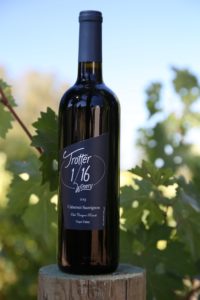 Stephanie picked these grapes with a group of friends she affectionately refers to as the “Sistas of D’Vine,”, friends that help her during harvest each year. The grapes from these vines was enough to make merely two barrels of wine or a total of 49 cases. Trotter 1/16th is certainly one of the smaller commercial producers in all of Napa Valley.
Stephanie picked these grapes with a group of friends she affectionately refers to as the “Sistas of D’Vine,”, friends that help her during harvest each year. The grapes from these vines was enough to make merely two barrels of wine or a total of 49 cases. Trotter 1/16th is certainly one of the smaller commercial producers in all of Napa Valley.
Stephanie strives to produce wines that are balanced and are approachable early on but have all the characteristics for aging. Throughout her lengthy career in Napa Valley, she has met numerous individuals who have provided winegrowing and winemaking advice including Randal Johnson (Hess Collection) and later in her career, winemakers Mario Tedeschi and David Sundberg.
Changing the appellation source completely in 2013 and 2014, Stephanie now sources fruit from tiny private vineyards in Coombsville, one of Napa Valley’s 17 sub-appellations, located just east of the city of Napa. These vineyards are dry farmed and generally organically or bio dynamically farmed. One vineyard is so small that she and her friends pick all 36 rows each year of fruit. Production has also increased with these subsequent vintages; now Stephanie makes a grand total of 4-5 barrels or approximately 100 cases. The focus of her micro production is on producing Cabernet Sauvignon but in 2017 she sourced outside of Napa Valley to Amador County for Verdelho, a Portuguese white variety.
Stephanie sources from what we call “backyard” vineyards in Napa Valley – small vineyards that are typically located behind the vintner’s home. Another Coombsville vineyard she sources from is so tiny that Stephanie named it herself (the E & S Vineyard). Because of its size, this vineyard would be block in a larger vineyard but even with its tiny footprint there are variations in grapes between various vines because of the differences in sun light exposure and the fact that some of the vines are planted near tall trees. Regardless, this is vineyard that produces very flavorful Cabernet Sauvignon grapes.
Coombsville is characterized as a moderate to cooler growing climate compared to up valley due to its proximity to the nearby San Pablo Bay with its cooling morning and afternoon breezes and often fog influences. The region is generally composed of low rolling hills with a diversity of micro climates even within this small region. The soils are volcanic, with Coombsville sitting within the remnants of an old caldera. It tends to be slightly warmer in vineyards that are located towards the edge of the southern part of the Vaca mountain range.
Producers in this AVA tend to be small and family owned – none of the wineries located here are open to the public by walk-in. A small vineyard located in this AVA produces what is typically Napa’s most expensive bottle of wine under the Ghosthorse label. Coombsville originally was thought to be to cold to grow Cabernet Sauvignon. Vineyards have proved this thinking wrong and this variety is certainly sought after by a number of premium producers who are looking to make elegant wines expressing varietal characteristics. Most of the Cabernet Sauvignon in this AVA is grown close to the edges of the hills where the micro climates are slightly warmer than other parts of the region.
We helped Stephanie pick some grapes one year from the organically farmed Oak Canyon Ranch nestled against the hills of the east side of Coombsville (less than an acre of vines) – here are a few photos from this fun outing:
Select Wines
The 2022 Trotter 1/16th Ben’s Blend, Napa Valley is named in homage to Stephanie’s husband Ben. This wine is a 50/50 blend of Cabernet Sauvignon and Cabernet Franc. Each variety was aged for 27 months in French oak barrels before being blended prior to bottling. This wine is medium to deep ruby in color; its aromatics are red fruited, savory and offer some dark spices. This wine smells like raspberry, red plums, red cherries, lavender, rose petals, smoked sage, crushed pepper, library book and old cedar box that hasn’t been opened in some time. The aromatics have more character than many red wines from Napa Valley this vintage which tended to be riper expressions of the variety. If you were in the valley in September and October that year, you clearly remember the extended heat spell centered around Labor Day weekend. Balanced and more red fruited than dark on the palate, this wine tastes like cherry, raspberry, boysenberry, cranberry and red plums. Finishes with a light tart character and lightly grainy tannins felt more on the front of the palate than the back. We would like to enjoy this with the moto guzzi pizza (Italian sausage, Swiss chard and house made smoked mozzarella) at Rosso Pizzeria & Wine Bar in Santa Rosa, CA.
The 2022 Trotter 1/16th Cabernet Sauvignon Flying J’s Vineyard Napa Valley, Coombsville was aged for 27 months in French oak barrels. The wine is medium ruby in color; red fruited the bouquet sports aromas of cherry, currant, cranberry, not fully ripe boysenberry, Santa Rosa plum and dried sage. The marriage of oak creates a savory and non-fruited sensibility, including of toasted wood, pipe tobacco and old cedar box. And as the wine evolves it expresses darker baking spices including clove. Balanced with a bright acidity, the palate offers flavors of red cherry, red plum, red currant, cranberry and raspberry. This wine finishes juicy which is not a word we often use to describe the 2022 vintage for red wines in Napa Valley, and brightly lit and refreshing. The tannins linger with a grainy textural feel. Pair with lighter style meats; this bottling would most likely pair well with a grilled rack of lamb covered in an assortment of dried herbs and darker spices.
The 2022 Trotter 1/16th Cabernet Franc, Carpenter Vineyard Napa Valley, St. Helena is medium ruby in color; the focus of the bouquet is on the fruit with its oak influence taking a back seat. This wine smells vibrant and fresh with aromas of red cherry, currant, red licorice, raspberry, strawberry, red plums and a hint of dried rosemary and sage. Shyly hiding deeper in the aromatics but more expressive as the wine opens, are some sweeter scents including brown sugar, cloves, mocha and vanilla. This wine is fully ripe at its listed ABV of 13.4% and sans of any herbal or green characteristics both on the bouquet and the palate. Singing brightly from both a driving acidity and red fruits, this wine tastes like tart cherry, cranberry, pomegranate, raspberry and currant. The seamlessly integrated tannins lighter with a light dusty and gravelly character, persisting in tandem with the fruit on the finish. Perfect pairings? Pork shoulder. Lamb roast. This wine is an absolutely a standout from a particularly challenging vintage. It is built to age to.

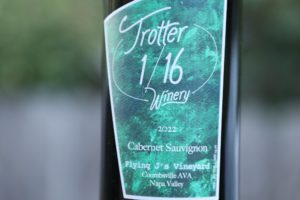
 The 2018 Trotter 1/16th Cabernet Sauvignon, Oak Canyon Ranch Coombsville is medium to dark ruby in color; offers aromas of dark herbs, dried sage, white pepper, tobacco, red licorice, bramble thicket and old cedar box. As the wine continues to evolve in the glass shows some notes of mocha, espresso and old leather. Offers flavors of red cherry, dark raspberry, currant and a very subtle hint of anise on the finish. The well-integrated tannins are fine grained, rounded and slightly silty in their textural feel. Lingers with bright acidity and a darker slightly savory note. This wine is highly approachable in its youth and already nicely balanced. Like with Stephanie’s other wines, this was fermented in open top bins with manual punch downs occurring several times a day. Post fermentation, the wine was aged for 31 months in small American oak barrels.
The 2018 Trotter 1/16th Cabernet Sauvignon, Oak Canyon Ranch Coombsville is medium to dark ruby in color; offers aromas of dark herbs, dried sage, white pepper, tobacco, red licorice, bramble thicket and old cedar box. As the wine continues to evolve in the glass shows some notes of mocha, espresso and old leather. Offers flavors of red cherry, dark raspberry, currant and a very subtle hint of anise on the finish. The well-integrated tannins are fine grained, rounded and slightly silty in their textural feel. Lingers with bright acidity and a darker slightly savory note. This wine is highly approachable in its youth and already nicely balanced. Like with Stephanie’s other wines, this was fermented in open top bins with manual punch downs occurring several times a day. Post fermentation, the wine was aged for 31 months in small American oak barrels.
The 2011 Trotter 1/16th Cabernet Sauvignon David Fulton Vineyard, Napa Valley St. Helena initially shows nuances of cassis, subtle notes of cedar along with various baking spices and notes of mocha. But the wine soon reveals its power – its fruit. Blackberry, blackberry pie and black and red cherry. The mouth feel is soft and silky with depth in the mid palate. Very good acidity. For a young wine the tannins are very well integrated and fine-grained. They linger delicately for some time, but more so in the front of the palate rather than the back. There is a slight dusty or earthy component that lingers on the finish. This is a wine that tends to hold up well for some time after it has been opened. 2011 was a challenging vintage with early rains and was generally a cooler year. A number of valley floor wines from this vintage that we have tried certainly carry vintage characteristics often with varying degrees of herbal notes. This Trotter 1/16th bottling is not one of those ‘greener’ expressions. Only 48 cases of this beauty were produced.
—
Stephanie enters her wines into a number of well-regarded wine competitions, often within the state of California. Her wines have been highly appreciated, at times taking home silver, gold and double gold medals for her craft. And her colorful labels were designed by artist Jeannine Luke; she was raised in Napa Valley, now lives in Sonoma and is also known for her paint and sip courses. Her works have been on exhibition at the Big Sur Coast Gallery in Big Sur, California and one of her pieces is on permanent display at the Fremantle Museum in Fiesole, near Florence, in Tuscany, Italy.
Because of such a small production the wine is only available direct via the website. For more information or to join the Liquid Art Club (with two shipments each year, once in spring and once in fall), visit: www.116wines.com

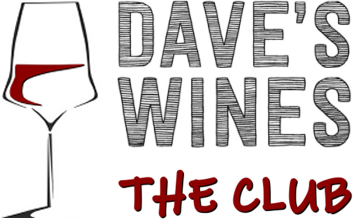





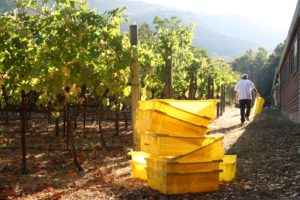
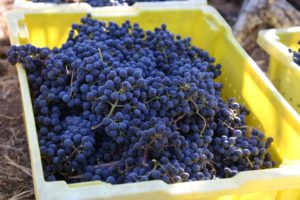
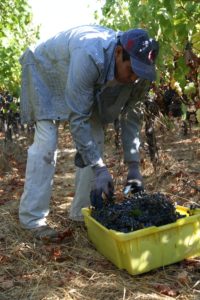
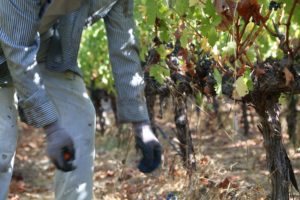
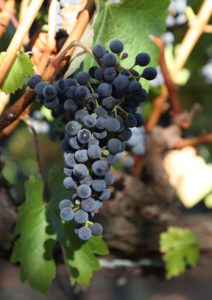
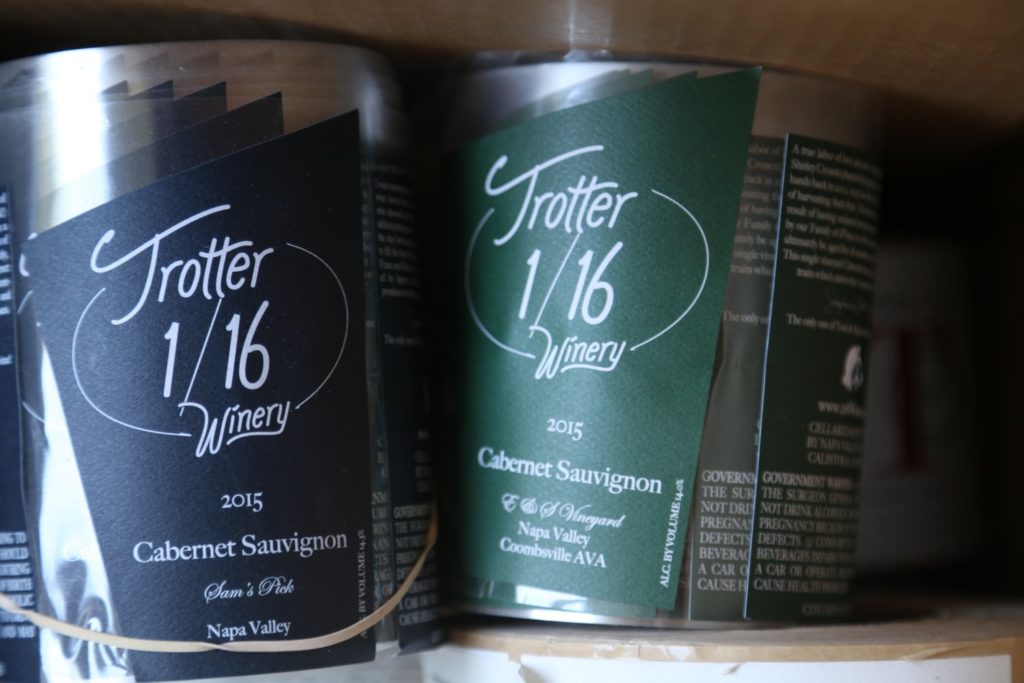
Leave a Reply